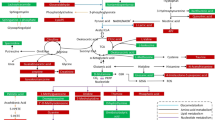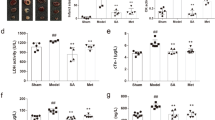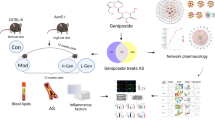Abstract
Indole-3-propionic acid (IPA), a gut microbiota-derived metabolite of tryptophan, has been proven to fulfill an essential function in cardiovascular disease (CVD) and nerve regeneration disease. However, the role of IPA in aortic dissection (AD) has not been revealed. We aimed to investigate the role of IPA in the pathogenesis of AD and the underlying mechanisms of IPA in endothelial dysfunction. Untargeted metabolomics has been employed to screen the plasma metabolic profile of AD patients in comparison with healthy individuals. Network pharmacology provides insights into the potential molecular mechanisms underlying IPA. 3-aminopropionitrile fumarate (BAPN) and angiotensin II (Ang II) were administered to induce AD in mice, while human umbilical vein endothelial cells (HUVECs) were employed for in vitro validation of the signaling pathways predicted by network pharmacology. A total of 224 potentially differential plasma metabolites were identified in the AD patients, with 110 up-regulated metabolites and 114 down-regulated metabolites. IPA was the most significantly decreased metabolite involved in tryptophan metabolism. Bcl2, caspase3, and AKT1 were predicted as the target genes of IPA by network pharmacology and molecular docking. IPA suppressed Ang II-induced apoptosis, intracellular ROS generation, inflammation, and endothelial tight junction (TJ) loss. Animal experiments demonstrated that administration of IPA alleviated the occurrence and severity of AD in mice. Taken together, we identified a previously unexplored association between tryptophan metabolite IPA and AD, providing a novel perspective on the underlying mechanism through which IPA mitigates endothelial dysfunction to protect against AD.










Similar content being viewed by others

Data availability
The datasets generated during and/or analysed during the current study are not publicly available due to relevant ongoing research but are available from the corresponding author on reasonable request.
References
Zhu Y, Lingala B, Baiocchi M, Tao JJ, Toro Arana V, Khoo JW et al (2020) Type A aortic dissection-experience over 5 decades: JACC historical breakthroughs in perspective. J Am Coll Cardiol 76:1703–1713
Isselbacher EM, Preventza O, Hamilton Black 3rd J, Augoustides JG, Beck AW, Bolen MA et al (2022) 2022 ACC/AHA guideline for the diagnosis and management of aortic disease: a report of the American Heart Association/American College of Cardiology Joint Committee on Clinical Practice Guidelines. Circulation 146:e334–e482
Bai B, Yang Y, Wang Q, Li M, Tian C, Liu Y et al (2020) NLRP3 inflammasome in endothelial dysfunction. Cell Death Dis 11:776
Yang X, Xu C, Yao F, Ding Q, Liu H, Luo C et al (2023) Targeting endothelial tight junctions to predict and protect thoracic aortic aneurysm and dissection. Eur Heart J 44:1248–1261
Folkersen L, Gustafsson S, Wang Q, Hansen DH (2020) Genomic and drug target evaluation of 90 cardiovascular proteins in 30,931 individuals. Nat Metab 2:1135–1148
Cui H, Chen Y, Li K, Zhan R, Zhao M, Xu Y et al (2021) Untargeted metabolomics identifies succinate as a biomarker and therapeutic target in aortic aneurysm and dissection. Eur Heart J 42:4373–4385
Lieberg J, Wanhainen A, Ottas A, Vähi M, Zilmer M, Soomets U et al (2021) Metabolomic profile of abdominal aortic aneurysm. Metabolites. https://doi.org/10.3390/metabo11080555
Yang Y, Karampoor S, Mirzaei R, Borozdkin L, Zhu P (2023) The interplay between microbial metabolites and macrophages in cardiovascular diseases: a comprehensive review. Int Immunopharmacol 121:110546
Hwang IK, Yoo KY, Li H, Park OK, Lee CH, Choi JH et al (2009) Indole-3-propionic acid attenuates neuronal damage and oxidative stress in the ischemic hippocampus. J Neurosci Res 87:2126–2137
Kwun MS, Lee DG (2021) Investigation of distinct contribution of nitric oxide and each reactive oxygen species in indole-3-propionic-acid-induced apoptosis-like death in Escherichia coli. Life Sci 285:120003
Rothhammer V, Mascanfroni ID, Bunse L (2016) Type I interferons and microbial metabolites of tryptophan modulate astrocyte activity and central nervous system inflammation via the aryl hydrocarbon receptor. Nat Med 22:586–597
Zhao ZH, Xin FZ, Xue Y, Hu Z, Han Y, Ma F et al (2019) Indole-3-propionic acid inhibits gut dysbiosis and endotoxin leakage to attenuate steatohepatitis in rats. Exp Mol Med 51:1–14
Xie Y, Zou X, Han J, Zhang Z, Feng Z, Ouyang Q et al (2022) Indole-3-propionic acid alleviates ischemic brain injury in a mouse middle cerebral artery occlusion model. Exp Neurol 353:114081
Krug D, Zurek G, Schneider B, Garcia R, Müller R (2008) Efficient mining of myxobacterial metabolite profiles enabled by liquid chromatography-electrospray ionisation-time-of-flight mass spectrometry and compound-based principal component analysis. Anal Chim Acta 624:97–106
Wang Q, Yesitayi G, Liu B, Siti D, Ainiwan M, Aizitiaili A et al (2023) Targeting metabolism in aortic aneurysm and dissection: from basic research to clinical applications. Int J Biol Sci 19:3869–3891
Huang J, Li Y, Lu Z, Che Y, Sun S, Mao S et al (2019) Analysis of functional hub genes identifies CDC45 as an oncogene in non-small cell lung cancer—a short report. Cell Oncol (Dordr) 42:571–578
Nicolini G, Forini F, Kusmic C, Iervasi G, Balzan S (2019) Angiopoietin 2 signal complexity in cardiovascular disease and cancer. Life Sci 239:117080
Pan L, Lin Z, Tang X, Tian J, Zheng Q, Jing J et al (2020) S-Nitrosylation of plastin-3 exacerbates thoracic aortic dissection formation via endothelial barrier dysfunction. Arterioscler Thromb Vasc Biol 40:175–188
Jones DT, Ganeshaguru K, Anderson RJ, Jackson TR, Bruckdorfer KR, Low SY et al (2003) Albumin activates the AKT signaling pathway and protects B-chronic lymphocytic leukemia cells from chlorambucil- and radiation-induced apoptosis. Blood 101:3174–3180
Melgar-Lesmes P, Tugues S, Ros J, Fernández-Varo G, Morales-Ruiz M, Rodés J et al (2009) Vascular endothelial growth factor and angiopoietin-2 play a major role in the pathogenesis of vascular leakage in cirrhotic rats. Gut 58:285–292
Lin MT, Beal MF (2006) Mitochondrial dysfunction and oxidative stress in neurodegenerative diseases. Nature 443:787–795
König T, Nolte H, Aaltonen MJ (2021) MIROs and DRP1 drive mitochondrial-derived vesicle biogenesis and promote quality control. Nat Cell Biol 23:1271–1286
Liu J, Liu W, Lu Y, Tian H, Duan C, Lu L et al (2018) Piperlongumine restores the balance of autophagy and apoptosis by increasing BCL2 phosphorylation in rotenone-induced Parkinson disease models. Autophagy 14:845–861
Xue M, Minhas N, Chow SO, Dervish S, Sambrook PN, March L et al (2010) Endogenous protein C is essential for the functional integrity of human endothelial cells. Cell Mol Life Sci 67:1537–1546
Witkowski M, Weeks TL, Hazen SL (2020) Gut microbiota and cardiovascular disease. Circ Res 127:553–570
Wang Q, Ding Y, Song P, Zhu H, Okon I, Ding YN et al (2017) Tryptophan-derived 3-hydroxyanthranilic acid contributes to angiotensin ii-induced abdominal aortic aneurysm formation in mice in vivo. Circulation 136:2271–2283
Li Q, You Y, Zeng Y, Wang X, Pan Z, Pang J et al (2022) Associations between plasma tryptophan and indole-3-propionic acid levels and mortality in patients with coronary artery disease. Am J Clin Nutr 116:1070–1077
Xue H, Chen X, Yu C, Deng Y, Zhang Y, Chen S (2022) Gut microbially produced indole-3-propionic acid inhibits atherosclerosis by promoting reverse cholesterol transport and its deficiency is causally related to atherosclerotic cardiovascular disease. Circ Res 131:404–420
Kim C-S, Jung S, Hwang G-S, Shin D-M (2023) Gut microbiota indole-3-propionic acid mediates neuroprotective effect of probiotic consumption in healthy elderly: a randomized, double-blind, placebo-controlled, multicenter trial and in vitro study. Clin Nutr 42:1025–1033
Nienaber CA, Clough RE, Sakalihasan N, Suzuki T, Gibbs R, Mussa F et al (2016) Aortic dissection. Nat Rev Disease Prim 2:16053
Chakraborty A, Li Y, Zhang C, Li Y, Lemaire SA, Shen YH (2022) Programmed cell death in aortic aneurysm and dissection: a potential therapeutic target. J Mol Cell Cardiol 163:67–80
Carrel T, Sundt 3rd TM, Von Kodolitsch Y, Czerny M (2023) Acute aortic dissection. Lancet 401:773–788
Rombouts KB (2022) Van Merrienboer TAR, Ket JCF, Bogunovic N The role of vascular smooth muscle cells in the development of aortic aneurysms and dissections. Eur J Clin Investig 52:e13697
Zhang Y, Song Z, Huang S, Zhu L, Liu T, Shu H et al (2020) Aloe emodin relieves Ang II-induced endothelial junction dysfunction via promoting ubiquitination mediated NLRP3 inflammasome inactivation. J Leucocyte Biol 108:1735–1746
Deanfield JE, Halcox JP, Rabelink TJ (2007) Endothelial function and dysfunction: testing and clinical relevance. Circulation 115:1285–1295
Oduro PK, Zheng X, Wei J, Yang Y, Wang Y, Zhang H et al (2022) The cGAS-STING signaling in cardiovascular and metabolic diseases: future novel target option for pharmacotherapy. Acta Pharm Sin B 12:50–75
Duan MX, Zhou H (2019) Andrographolide protects against HG-induced inflammation, apoptosis, migration, and impairment of angiogenesis via PI3K/AKT-eNOS signalling in HUVECs. Mediat Inflamm 2019:6168340
Li J, Chen Q, He X, Alam A, Ning J, Yi B et al (2018) Dexmedetomidine attenuates lung apoptosis induced by renal ischemia-reperfusion injury through α(2)AR/PI3K/Akt pathway. J Transl Med 16:78
Lin HK, Yeh S, Kang HY, Chang C (2001) Akt suppresses androgen-induced apoptosis by phosphorylating and inhibiting androgen receptor. Proc Natl Acad Sci USA 98:7200–7205
Konopelski P, Mogilnicka I (2022) Biological effects of indole-3-propionic acid, a gut microbiota-derived metabolite, and its precursor tryptophan in mammals’ health and disease. Int J Mol Sci 23:1222
Zhang LS, Davies SS (2016) Microbial metabolism of dietary components to bioactive metabolites: opportunities for new therapeutic interventions. Genome Med 8:46
Garcez ML, Tan VX, Heng B (2020) Sodium butyrate and indole-3-propionic acid prevent the increase of cytokines and kynurenine levels in LPS-induced human primary astrocytes. Int J Tryptophan Res 13:1178646920978404
Du L, Qi R, Wang J, Liu Z, Wu Z (2021) Indole-3-propionic acid, a functional metabolite of clostridium sporogenes, promotes muscle tissue development and reduces muscle cell inflammation. Int J Mol Sci 22:12435
Zhao M, Wang Y, Li L, Liu S, Wang C, Yuan Y et al (2021) Mitochondrial ROS promote mitochondrial dysfunction and inflammation in ischemic acute kidney injury by disrupting TFAM-mediated mtDNA maintenance. Theranostics 11:1845–1863
Su X, Gao Y, Yang R (2022) Gut microbiota-derived tryptophan metabolites maintain gut and systemic homeostasis. Cells 11:2296
Zhao Q, Chen T, Ni C, Hu Y, Nan Y, Lin W et al (2022) Indole-3-propionic acid attenuates HI-related blood-brain barrier injury in neonatal rats by modulating the PXR signaling pathway. ACS Chem Neurosci 13:2897–2912
Perler BK, Friedman ES, Wu GD (2023) The role of the gut microbiota in the relationship between diet and human health. Annu Rev Physiol 85:449–468
Li J, Zhang L, Wu T, Li Y, Zhou X, Ruan Z (2021) Indole-3-propionic acid improved the intestinal barrier by enhancing epithelial barrier and mucus barrier. J Agric Food Chem 69:1487–1495
Konopelski P, Chabowski D, Aleksandrowicz M (2021) Indole-3-propionic acid, a tryptophan-derived bacterial metabolite, increases blood pressure via cardiac and vascular mechanisms in rats. Am J Physiol Regul Integr Compar Physiol 321:R969–R981
Liu F, Sun C, Chen Y, Du F, Yang Y, Wu G (2021) Indole-3-propionic acid-aggravated CCl(4)-induced liver fibrosis via the TGF-β1/Smads signaling pathway. J Clin Transl Hepatol 9:917–930
Serger E, Luengo-Gutierrez L (2022) The gut metabolite indole-3 propionate promotes nerve regeneration and repair. Nature 607:585–592
Funding
This work was funded by the Sponsored by Natural Science Foundation of Xinjiang Uygur Autonomous Region (No. 2022D01D66), National Natural Science Foundation of China (No. 82360090), State Key Laboratory of Pathogenesis, Prevention and Treatment of High Incidence Diseases in Central Asia Fund (SKL-HIDCA-2021-3), and Postgraduate Research Innovation Project of Xinjiang Uygur Autonomous Region (No. XJ2023G158).
Author information
Authors and Affiliations
Contributions
Conceptualization, Qi Wang and Xiang Ma; Data curation, Mierxiati Ainiwan; Investigation, Aliya Aizitiaili; Methodology, Hui Lv, Gulinazi Yesitayi and Asiya Abudesimu; Supervision, Qi Wang and Xiang Ma; Validation, Hui Lv, Mierxiati Ainiwan, Gulinazi Yesitayi and Dilixiati Siti; Writing—original draft, Qi Wang; Writing—review and editing, Qi Wang and Xiang Ma.
Corresponding author
Ethics declarations
Conflict of interest
The authors declare no conflict of interest.
Ethical approval
This study was performed in line with the principles of the Declaration of Helsinki. Approval was granted by the Ethics Committee of The study was conducted in accordance with the Declaration of Helsinki, and approved by the Medical Ethics Committee of the First Affiliated Hospital of Xinjiang Medical University (230306-88). The animal study protocol was approved by the Animal Ethics Committee of the First Affiliated Hospital of Xinjiang Medical University. We confirmed that all methods were carried out in accordance with relevant regulations and informed consent was obtained from patients.
Informed consent
Informed consent was obtained from all subjects involved in the study.
Additional information
Publisher's Note
Springer Nature remains neutral with regard to jurisdictional claims in published maps and institutional affiliations.
Supplementary Information
Below is the link to the electronic supplementary material.
Rights and permissions
Springer Nature or its licensor (e.g. a society or other partner) holds exclusive rights to this article under a publishing agreement with the author(s) or other rightsholder(s); author self-archiving of the accepted manuscript version of this article is solely governed by the terms of such publishing agreement and applicable law.
About this article
Cite this article
Wang, Q., Lv, H., Ainiwan, M. et al. Untargeted metabolomics identifies indole-3-propionic acid to relieve Ang II-induced endothelial dysfunction in aortic dissection. Mol Cell Biochem (2024). https://doi.org/10.1007/s11010-024-04961-x
Received:
Accepted:
Published:
DOI: https://doi.org/10.1007/s11010-024-04961-x



